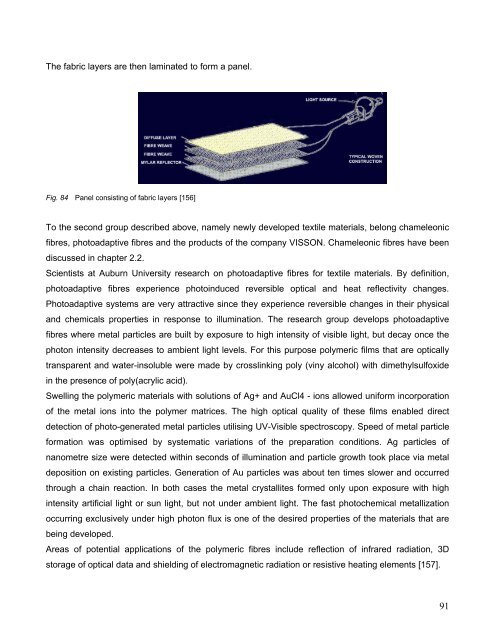Clevertex - Grado Zero Espace Srl
Clevertex - Grado Zero Espace Srl
Clevertex - Grado Zero Espace Srl
Create successful ePaper yourself
Turn your PDF publications into a flip-book with our unique Google optimized e-Paper software.
The fabric layers are then laminated to form a panel.<br />
Fig. 84 Panel consisting of fabric layers [156]<br />
To the second group described above, namely newly developed textile materials, belong chameleonic<br />
fibres, photoadaptive fibres and the products of the company VISSON. Chameleonic fibres have been<br />
discussed in chapter 2.2.<br />
Scientists at Auburn University research on photoadaptive fibres for textile materials. By definition,<br />
photoadaptive fibres experience photoinduced reversible optical and heat reflectivity changes.<br />
Photoadaptive systems are very attractive since they experience reversible changes in their physical<br />
and chemicals properties in response to illumination. The research group develops photoadaptive<br />
fibres where metal particles are built by exposure to high intensity of visible light, but decay once the<br />
photon intensity decreases to ambient light levels. For this purpose polymeric films that are optically<br />
transparent and water-insoluble were made by crosslinking poly (viny alcohol) with dimethylsulfoxide<br />
in the presence of poly(acrylic acid).<br />
Swelling the polymeric materials with solutions of Ag+ and AuCl4 - ions allowed uniform incorporation<br />
of the metal ions into the polymer matrices. The high optical quality of these films enabled direct<br />
detection of photo-generated metal particles utilising UV-Visible spectroscopy. Speed of metal particle<br />
formation was optimised by systematic variations of the preparation conditions. Ag particles of<br />
nanometre size were detected within seconds of illumination and particle growth took place via metal<br />
deposition on existing particles. Generation of Au particles was about ten times slower and occurred<br />
through a chain reaction. In both cases the metal crystallites formed only upon exposure with high<br />
intensity artificial light or sun light, but not under ambient light. The fast photochemical metallization<br />
occurring exclusively under high photon flux is one of the desired properties of the materials that are<br />
being developed.<br />
Areas of potential applications of the polymeric fibres include reflection of infrared radiation, 3D<br />
storage of optical data and shielding of electromagnetic radiation or resistive heating elements [157].<br />
91

















